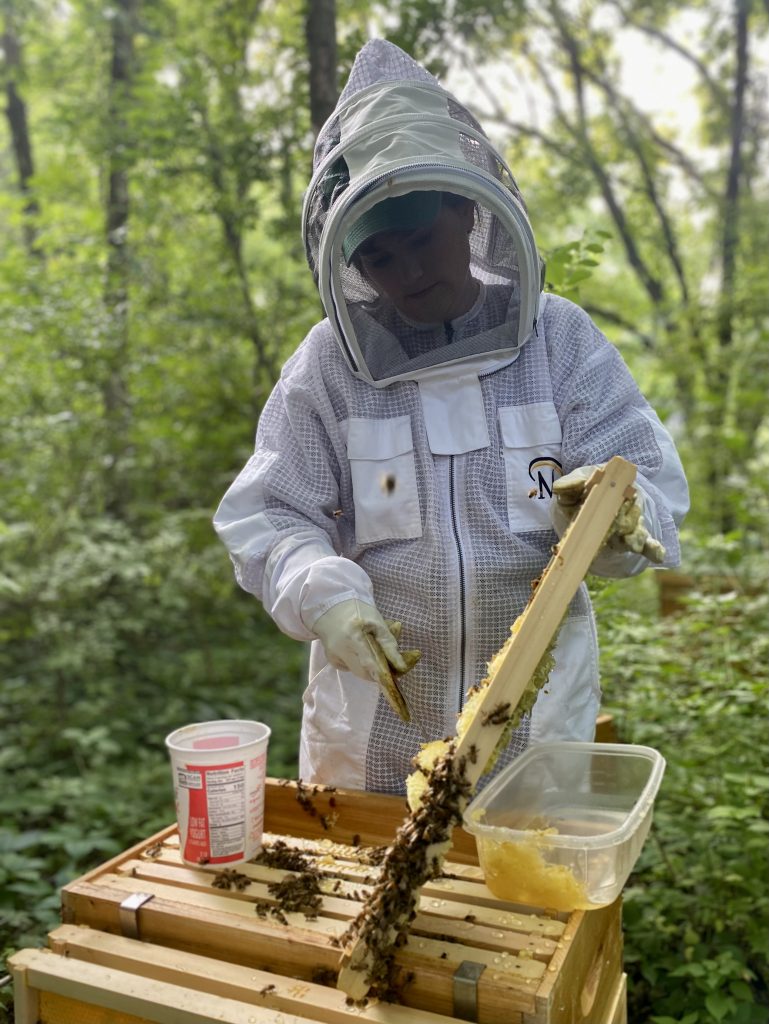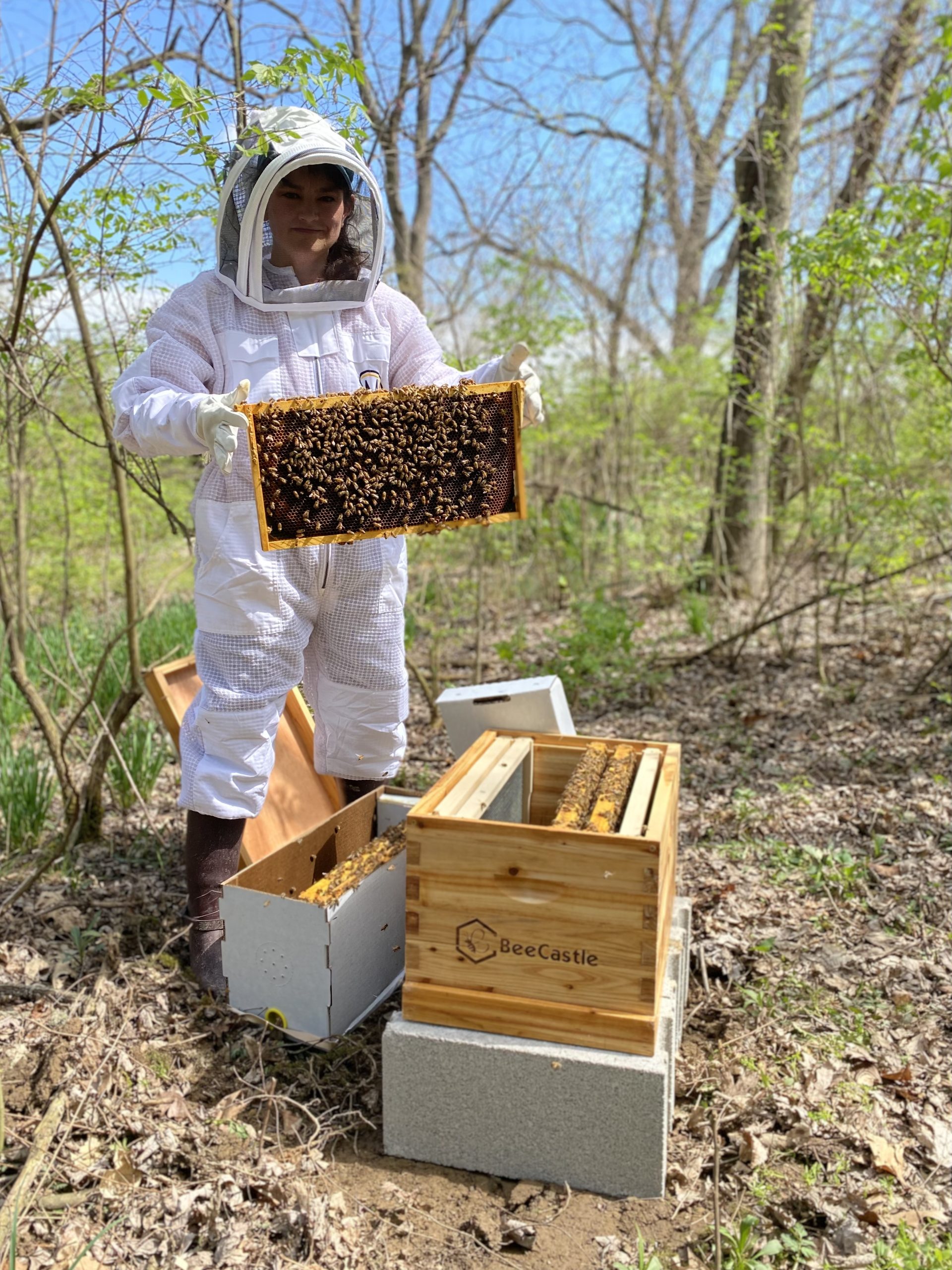There are a lot of options and different schools of thought on what PPE (Personal Protective Equipment) is best for beekeeping. I’ve seen beekeepers that wear literally no protective gear and all variations up to what I prefer – a full suit, veil, gloves, and boots.
While I’m not allergic to bee stings, I do find them rather bothersome and I try to avoid them. However, no matter what precautions you take, stings do come with the territory despite PPE.
As a novice beekeeper, I find it reassuring to have the extra layer of protection. The more that you become familiar with the bees’ habits, the nuances in how to handle the frames, and know your colony, you might find that you are more comfortable with less PPE.
For example, the most perfect conditions for inspecting my hives are when the temperatures are between 60F-80F (16C-27C), no precipitation, and no wind. I find it’s best to inspect between about 11 am – 3 pm, this is when most of the forager bees are out of the hive, so there are overall fewer bees inside of the hive to defend it by attacking you. This coincides with the peak amount of sunlight in our region, though you may need to adjust this for your region; what’s important is that it’s not too early or too late – with darkness, more bees are in the hive.
It’s also important to note that during dearth (scarcity of resources for the bees to forage) which typically occurs in July in Ohio, and also in late fall – the bees are particularly testy as they want to do everything they can to protect the resources they have.
As most inspections will be happening during the hottest months of the year, ventilation is key for your comfort. Depending on what you are doing during the inspection, you could end up spending an hour or so per hive to do a ‘deep dive.’

All that being said, let’s break down the different options:
- Ventilated Full Suit With Fencing Veil & Leather Gloves: This is the option that I use. The shape of the fencing veil helps to keep the mesh from getting too close to my skin which would allow the bees to sting through it. As added protection, I wear a baseball cap to further hold it away from my skin, which is particularly handy when I’m maneuvering around throughout the inspection. I also like that I can unzip just the front of the veil if I need to take a water break, instead of fully removing my veil. I have thus far not been stung through the veil or suit itself, however I do get shallow stings around my wrist occasionally from my aggressive hive. This option runs about $130 or so on Amazon. I added my knee-high rubber rain boots that tighten down at the top so no bees can get in to sting my ankle. In general, they like to go for the face or your hands, but some bees are absolutely determined to find any weak spot they can.
- Ventilated Full Suit With Round Veil & Leather Gloves: This is similar to what I use, though the round veil is not as convenient in my opinion, as you’d need to fully remove it if you need to take a water break – which can be very necessary during the 90F (32C) days while you’re doing an extensive inspection. This option is also around $130 or so on Amazon.
- Ventilated Jacket With Veil & Leather Gloves: This option covers the common sites that bees will sting while also giving you more freedom of movement and one less layer to have to wear in the heat. Sometimes beekeepers will pair this with a pair of jeans that help to minimize stings. These usually run about $70-$100 on Amazon.
- Veil Only: This option is fairly minimalistic, though it does provide protection to your face and ears – both of which tend to develop more swelling when stung. This provides a lot of options for adjusting your clothing for more or less ventilation. This typically runs about $25 on Amazon.
- No PPE: I’d personally advise to wait to try this until you are very comfortable around the bees, and to be honest I don’t think that I will ever get to the level of comfort that I’d want to go without PPE. There are too many factors that can come into play that could cause the bees to be very defensive of their resources; even if the weather, time of year, and daylight are perfect, if for example the queen has died, the bees will be very defensive. I personally don’t want to take that chance.
Some beekeepers prefer nitrile gloves instead of using leather or faux leather. Nitrile offers some protection and allows more dexterity than the thicker leather gloves; and the theory is that since nitrile does not feel like skin the bees are less likely to sting it. I’m not sure I put too much stock in that theory though as the bees still will try to sting through my leather gloves and they definitely do not feel like human skin.
Whichever PPE option you choose, it is important to also have a plan in place if you receive a sting and develop an allergic reaction. An allergy can develop at any time in your life, so even if you were not previously allergic to bees, that does not mean that you’ll never develop an allergy.
Talk to your doctor about what they recommend to have on hand; for my personal safety kit I keep an epi pen, Benadryl (generic name diphenhydramine), and Pepcid (generic name famotidine – normally used as an antacid, but it is an antihistamine that is sometimes given in combination with other medications during an allergic reaction).

